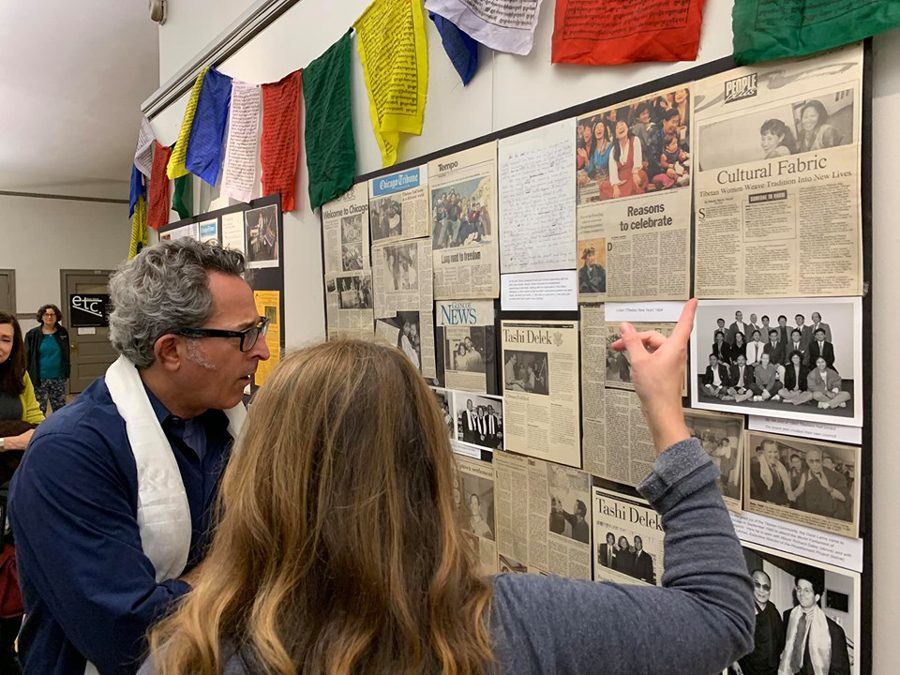Noyes Cultural Arts Center exhibit tells story of Tibetan community in Evanston
Exhibit-goers browse newspaper clippings from the the period when the Tibetan refugee community began to settle in Chicago. In addition to the articles, the “Tibetans in Chicago: A story of resilience and success” exhibit includes portraits, photos and letters.
May 24, 2019
Soon after the Immigration Act of 1990 was passed, Tibetan immigrants began to establish homes in Chicago. Fleeing a country where they lived under constant suspicion and violence from Chinese officials, these first immigrants struggled to establish a community in America in which they could prosper while at the same time preserving their cultural and social identity.
A new exhibit, “Tibetans in Chicago: A story of resilience and success,” opened last Friday at the Noyes Cultural Arts Center; it aims to tell the story of the presence of the Tibetan refugee population in Chicago. The exhibit documents the stories of a people who fled a home where they were no longer safe and managed not only to survive, but to thrive, with the help of the people of Chicago. The exhibit, located a few blocks northeast of the Tibetan Alliance of Chicago headquarters in Evanston, is open to the public daily and will be on display until August 23.
Tenchoe Wangyal, the secretary of the Tibetan Alliance and the daughter of one of the first members of the Tibetan community in Chicago, said it is crucial to preserve the Tibetan culture, which has been under threat for decades. She said it’s important to show how Tibetan culture has thrived in this community, which is now comprised of about 400 people.
“We, as exiles, treat it as our mission to ensure that the younger generations have an opportunity to keep our heritage alive; to protect and preserve our Tibetan culture,” Wangyal said. “We hope that we can continue on this path of awareness. It is a way to show people where we were way back in 1992 and where we are now, and to give thanks to the people who helped us get here.”
The exhibit, which celebrates the 25th anniversary of the Tibetan community coming to Chicago, consists of portraits, photos, newspaper clippings and letters community members wrote home to describe their experiences in Chicago. Organizers of the exhibit say it aims to celebrate the rich culture that this community has managed to preserve.
Tenzin Jamyang, the former president of the Tibetan Alliance and a political activist who has dedicated decades to bringing awareness to the plight of the Tibetan people, said the way that the exhibit tracks the progress of the community over 25 years is remarkable.
“The exhibit allowed us, and our American friends, to watch members of the community grow up, to learn a little bit about the history of Tibet and about what has happened in our community since 1992,” Jamyang said. “I saw a picture of myself in front of the United Nations headquarters when I was twenty-three and on a hunger strike, and I saw pictures of myself getting older over time. It allowed me to appreciate our history.”
Jeff Libman, who was the executive director of the Tibetan resettlement in the early 1990s, also stated that along with celebrating the rich cultural history of the community, the exhibit is meant to thank the city of Chicago for its role in welcoming Tibetan immigrants and helping their community to thrive despite all the challenges it faced.
Libman explained that because of political technicalities with China, Tibetan immigrants were not afforded refugee status and therefore received no funding from the government to help them establish, educate and maintain their community. However, with the help of a city that largely embraced their presence, they still managed to flourish.
“The help of the American volunteers to set up a Tibetan-run, Tibetan-organized and Tibetan-financed community was very important in helping this community to be so successful,” Libman said. “The people of this community really want to thank the Chicago community for providing the support that allowed that allowed them to become who they are now.”
Jeremy Pardoe, one of the organizers of the exhibit, said this exhibit is important because it brings awareness to a community that many did not even know existed. Pardoe described the exhibit as a celebration of a very unique culture.
“The story of this community is very important because it represents something greater, and that is the link to an international community that espouses very special values and a story that is both tragic and inspirational,” Pardoe said. “It’s a culture that champions kindness and being good to the people around you, and that’s very inspirational.”
Email: EvaJacobs2022@u.northwestern.edu
Twitter: @evvajacobs



